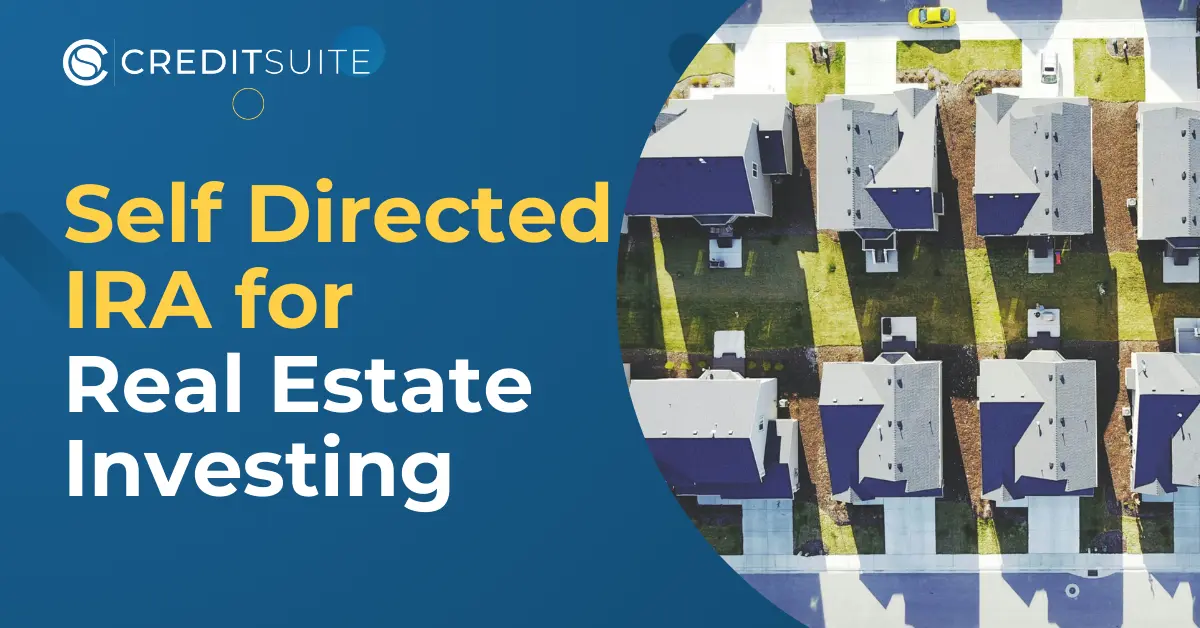A self-directed individual retirement account (SDIRA) allows you to hold investments that are typically not allowed with traditional IRAs, including precious metals, tax liens, commodities, and, of course, one of the most powerful assets of all–real estate.
Savvy investors leverage SDIRAs to diversify their investment portfolios and pad their retirement funds while taking advantage of tax breaks. However, SDIRAs come with several risks, just like any other financial product.
In this article, we’ll dive into the ins and outs of using this type of retirement account for real estate investing, the potential risks and benefits, and how to buy investment properties with your account.
What Is a Self-Directed IRA for Real Estate Investing?
You can’t buy an investment property with a traditional IRA, but a self-directed IRA will allow you to do so. In fact, you can invest in any type of real estate with an SDIRA, including land, rental properties, and commercial buildings. People who use their accounts for this purpose often use the term “Real Estate IRA.”
In general, a custodian or trustee–the company protecting the account and enforcing Internal Revenue Service (IRS) rules–administers self-directed IRA. However, the account holder manages the account directly, which is why it’s called self-directed.
Traditional IRAs are more common and are therefore more available. Real estate SDIRAs, on the other hand, are only accessible through specialized companies that offer real estate SDIRA custodian services, such as the Equity Trust Company and IRA Financial Group.
Unfortunately, many IRA custodians don’t offer these services, meaning finding one that does might not be easy. Moreover, custodians that provide these specialized services often charge higher fees.
But how does real estate self-directed IRA work?
The process of buying an investment property through an SDIRA is quite simple. Once you create and fund your retirement account, you can buy any investment property and title it under your real estate IRA. Proceeds from your investments will grow tax-deferred if you have a traditional IRA or tax-free if you have a Roth IRA, and if you sell the property, the funds will remain in your SDIRA.
Should I Use a Self-Directed IRA for Real Estate Investing?
A self-directed IRA is an excellent investment tool if you want to increase your potential retirement funds with diversified assets like real estate. Plus, you can combine your SDIRA with a traditional IRA and non-IRA assets or funds to optimize cash flow and increase your savings, whatever your financial goals may be.
However, just like any financial tool, there are potential pitfalls when using an SDIRA for real estate investing. To ensure you make informed decisions, let’s dissect the pros and cons of this investment strategy:
Pros
- Additional funds. A rental property provides additional cash flow that can supplement your retirement income and savings. The same goes for properties that you buy and sell, although they are not as liquid as rentals. Check out this blog on house flipper financing to learn more about your options.
- Appreciation: When you invest in real estate, time is on your side. Real estate is one of the few assets that appreciate over time, making it an excellent investment option for investors aiming for a more secure retirement in the future and retirees who want to optimize their finances for a longer amount of time.
- Hedging against inflation: Investing in real estate with an SDIRA instead of personal financing helps protect your retirement funds from volatile markets and inflation.
- Personalized diversification: In general, an SDIRA will allow you to invest in any alternative asset you want. Furthermore, investing in real estate with a retirement account is a great way to diversify your portfolio from other major asset classes, such as stocks and mutual funds. IRAs from big firms like Equity Trust also let account holders invest in cryptocurrency.
- Tax breaks: Income earned by an IRA is considered unrelated business income tax. You can enjoy tax breaks on the funds your investment properties earn, depending on the type of SDIRA you choose (Roth or traditional). However, you must meet certain conditions to maintain your tax advantages.
Cons
- Risky IRA investment: Investing in real estate requires prior knowledge, experience, and effective strategizing. Otherwise, you might end up with a bad investment, such as a fixer-upper home that would take a lot more money to fix than what you first thought.
- Lost tax benefits: If you buy a property with an IRA, you lose access to several real estate tax benefits, such as 1031 exchanges and deferred capital gains.
- Custodian fees: Finding an IRA custodian–and a good one, at that–that specializes in real estate SDIRAs can be tricky. Many of the best IRA custodians don’t want to take the risks that typically come with any real estate investment. When you do find a firm, they may charge higher fees compared to other custodians, which could affect your bottom line.
- Disqualifications: Transactions between a real estate IRA and a disqualified person are prohibited and may result in hefty fines.
- Prohibited transactions: When you purchase real estate with an IRA, there are prohibited transactions you must be aware of. Generally, these include the sale, exchange, or leasing to a disqualified person or the furnishing of goods, services, or facilities to a disqualified person, to name a few.
How To Invest in Real Estate with Your Self-Directed IRA
The potential benefits of a real estate SDRI outweigh the cons, but only if you know what you’re doing. Here’s a general guide on how to buy your first investment property with an SDIRA:
1. Open and Fund Your New Account
First things first, find a firm that specializes in real estate SDRI, such as Equity Trust. You can choose from a traditional IRA, Roth IRA, or solo 401(k). Here’s how these three differ:
- Traditional IRA: Funded by pre-tax dollars. You won’t have to pay taxes until you distribute the asset.
- Roth IRA: Funded by post-tax dollars. You can distribute the asset tax-free after you’re at least 59.5 years old. Additionally, the account must be active for at least five years.
- Solo 401(k): Funded by pre-tax dollars and operates similarly to a traditional IRA. These are retirement plans designed for small business owners with no employees apart from a spouse or business partner.
Some custodians offer a checkbook IRA, which is a convenient option that lets you write a check for a new investment.
Once you’ve chosen your account, decide on the best way to fund it. You can do this by transferring funds from one account to a similar type of account (e.g., traditional IRA to SDIRA), using rollover funds from a previous account, or making annual contributions (according to IRS contribution limits).
2. Study the Real Estate IRA Rules and Regulations
Next, make sure you read and understand the self-directed IRA rules, especially on disqualified persons and prohibited transactions. Breaking these rules could cost you your tax-advantaged status and lead to significant penalties.
At a glance, here are the most important self-directed IRA rules and regulations:
- Disqualified Persons: A disqualified person is someone who cannot transact or initiate with the account. Disqualified persons include you, your spouse, lineal descendants and their spouses, your employer, any business entity where you have at least a 50% stake, and any plan-providing services (e.g., custodians, trustees, etc.).
- Prohibited Transactions: The list of prohibited transactions varies far and wide, but in general, you cannot use the SDIRA to buy assets or stocks, lend or borrow, and lease assets to and from a disqualified person.
These rules sound complicated, but it pays to be deeply familiar with them. If you perform a transaction with a disqualified person, the entire account is considered distributed as of January 1st of the year wherein the transaction happened. Additionally, you will be subject to any taxes applicable to the distributed amount, and you may have to pay a 10% early withdrawal fine if the transaction occurred before you were 59.5 years old.
3. Find a Property and Extend an Offer
Here is the most exciting part of investing: finding the perfect investment property. If you are an experienced real estate investor, this should come naturally to you. Otherwise, we recommend working with experienced brokers or agents to find viable investment options.
Once you find a prospect, the next step is to make an offer. First, you need to decide how you’re going to pay for the property. There are several ways to finance an investment property with an SDIRA:
- Direct purchase: You can purchase the property in cash if your account has enough funds.
- Use other funds: Another option is to leverage other funds, such as your personal savings, credit card, funds from private lending, and investments from a real estate syndication. You can use your SDIRA in conjunction with any other fund, including your personal funds, for the first purchase only.
- Non-recourse loan: A non-recourse loan uses the funded asset as collateral, meaning you don’t need any other asset to qualify.
- Self-Directed IRA LLC: If you have a real estate IRA LLC, you can deposit funds into its account and use the checkbook to conduct real estate transactions.
Speak to your financial advisor to learn more about your financing options and other alternative investments you can consider.
How Credit Suite Can Help You
An SDIRA lets you hold any alternative investment you want, and if you’re an experienced investor, you’ll know that real estate is where it’s at.
However, IRA funds may not be enough to get the investment property you want. You also cannot borrow from the IRA itself. The good news is that there are other ways to supplement your capital.
CreditSuite offers several solutions that can help you get that coveted asset, including commercial real estate financing, working capital loans, term loans, and more. Better yet, we offer credit line hybrids to provide revolving funds for investors following the BRRRR Method (Buy, Rehab, Rent, Refinance, Repeat).
Make sure to check out our guide on creating a business plan for flipping houses to gain more insights into revamping investment properties.
FAQs
Can you put a rental property in a self-directed IRA?
Yes, you can put a rental property into an SDIRA as it’s considered an investment property. However, you cannot use the property as anything other than a rental, meaning you or your family cannot live in it.
Can I rent the property to my family?
No, you cannot rent an SDIRA property to disqualified persons, which includes family members. Always check with the self-directed IRA rules and consult your IRA custodian before making a transaction.
Can I act as a property manager for my investment property?
As the IRA owner and a disqualified person, you cannot manage the property or collect rental income directly. Typically, the IRA custodian sources property management professionals themselves.


